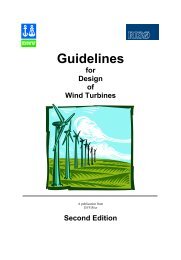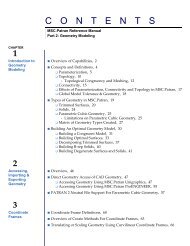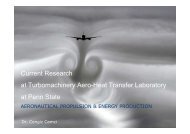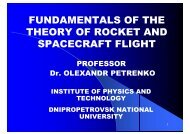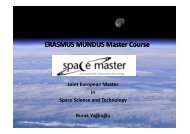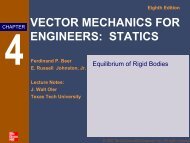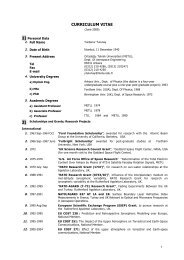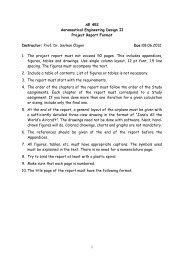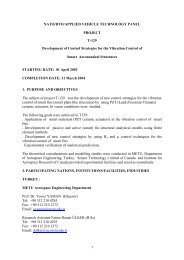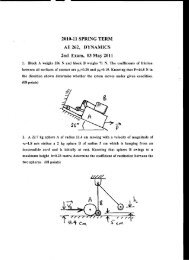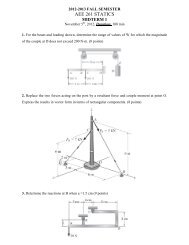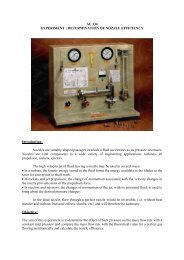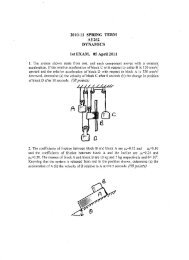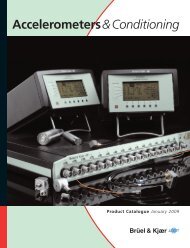Integrated Modular Avionics - Department of Aerospace Engineering
Integrated Modular Avionics - Department of Aerospace Engineering
Integrated Modular Avionics - Department of Aerospace Engineering
Create successful ePaper yourself
Turn your PDF publications into a flip-book with our unique Google optimized e-Paper software.
<strong>Integrated</strong> <strong>Modular</strong> <strong>Avionics</strong><br />
Development Guidance and Certification Considerations<br />
René L.C. Eveleens<br />
National <strong>Aerospace</strong> Laboratory NLR<br />
P.O. Box 90502<br />
1006BM Amsterdam<br />
RTO SCI LS-176: “Mission System <strong>Engineering</strong>”<br />
November 2006
Overview<br />
IMA Certification Guidance<br />
introduction to avionics certification processes<br />
certification guidance<br />
EUROCAE WG60 background<br />
the definition <strong>of</strong> IMA<br />
goal <strong>of</strong> the guidance document<br />
the concept <strong>of</strong> "incremental acceptance"<br />
IMA certification guidance document<br />
conclusion<br />
IMA development guidance and certification considerations Nov2006 2
Introduction<br />
System verification (1/2)<br />
differences / similarities with “normal testing”?<br />
main difference<br />
certification by an independent third party:<br />
certification authority<br />
other differences / similarities basically depend on your<br />
development and testing maturity...<br />
no requirements means: testing in the dark!<br />
IMA development guidance and certification considerations Nov2006 3
Introduction<br />
System verification (2/2)<br />
verification according to RTCA DO-178<br />
“… the evaluation <strong>of</strong> the results <strong>of</strong> a process to ensure<br />
correctness and consistency with respect to the inputs<br />
and standards to that process.”<br />
testing according to RTCA DO-178<br />
”… the process <strong>of</strong> exercising a system or system<br />
component to verify that it satisfies specified<br />
requirements and to detect errors.”<br />
but<br />
testing cannot show the absence <strong>of</strong> errors<br />
therefore extensive verification effort required<br />
– requirements analysis and traceability<br />
– consistent documentation<br />
IMA development guidance and certification considerations Nov2006 4
Introduction<br />
Certification processes<br />
INTENDED<br />
AIRCRAFT<br />
FUNCTION<br />
Function,<br />
Failure<br />
and Safety<br />
Information<br />
CERTIFICATION GUIDANCE THROUGH:<br />
Safety Assessment<br />
[SAE ARP 4761]<br />
<strong>Avionics</strong> System<br />
Development Processes<br />
[SAE ARP4754]<br />
System Design<br />
Functional<br />
System<br />
Functions and<br />
requirements<br />
SAE ARP 4754 Certification considerations for highly-integrated or complex aircraft systems<br />
SAE ARP 4761 Safety Assessment Process Guidelines & Methods<br />
RTCA DO-178B S<strong>of</strong>tware Considerations in Airborne Systems and Equipment Certification<br />
RTCA DO-254 EUROCAE ED-80 Design Assurance Guidance for Airborne Electronic Hardware<br />
RTCA DO-160D Environmental Test Specifications<br />
Supporting Processes<br />
Hardware<br />
Development Life-Cycle<br />
[RTCA DO-254]<br />
S<strong>of</strong>tware<br />
Development Life-Cycle<br />
[RTCA DO178B]<br />
Qualification<br />
<strong>Avionics</strong>/Electronics<br />
Integrity Program<br />
• Certification Coordination<br />
• Safety Assessment<br />
• Requirements Validation<br />
• Implementation verification<br />
• Configuration Management<br />
• Process Assurance<br />
<strong>Avionics</strong> System<br />
Integration and Test<br />
MIL-HDBK-87244 (USAF) <strong>Avionics</strong>/Electronics Integrity<br />
• Concept Exploration<br />
• Demonstration/Validation<br />
• <strong>Engineering</strong>/Manufacturing Development<br />
• Production<br />
• Operation & Support<br />
IMA development guidance and certification considerations Nov2006 5
Certification guidance<br />
DO-178B overview: introduction<br />
Not a development standard: a guideline for<br />
certification<br />
Emphasis on requirements-based development<br />
Emphasis on verification/testing<br />
Based on a system safety assessment, s<strong>of</strong>tware is<br />
assigned a safety criticality level<br />
Safety according to DO-178B: increasing<br />
verification/testing effort with increasing s<strong>of</strong>tware<br />
levels<br />
IMA development guidance and certification considerations Nov2006 6
Certification guidance<br />
S<strong>of</strong>tware criticality levels<br />
S<strong>of</strong>tware<br />
Level<br />
Aircraft level<br />
Criticality<br />
Meaning<br />
A Catastrophic Aircraft destroyed,<br />
Many fatalities<br />
B Hazardous Damage to aircraft,<br />
Crew overextended,<br />
Occupants hurt, some fatal<br />
C Major Large reduction in safety<br />
margins, occupants injury<br />
D Minor Little effect on operation <strong>of</strong><br />
aircraft and crew<br />
workload<br />
E No effect No effect on operation<br />
<strong>of</strong> aircraft or crew<br />
workload<br />
IMA development guidance and certification considerations Nov2006 7
Certification guidance<br />
Life cycle processes<br />
S<strong>of</strong>tware planning process (1 table with process<br />
objectives and outputs by s<strong>of</strong>tware level)<br />
S<strong>of</strong>tware development processes (1 table)<br />
S<strong>of</strong>tware verification processes (5 tables) [next slide]<br />
S<strong>of</strong>tware configuration management process (1 table)<br />
S<strong>of</strong>tware quality assurance process (1 table)<br />
Certification liaison process (1 table)<br />
IMA development guidance and certification considerations Nov2006 8
Certification guidance<br />
Objective tables (example)<br />
IMA development guidance and certification considerations Nov2006 9
Certification guidance<br />
S<strong>of</strong>tware Lifecycle Data Items<br />
Plan for Sw Aspects <strong>of</strong> Cert. (PSAC)<br />
S<strong>of</strong>tware Dev. Plan<br />
S<strong>of</strong>tware Ver. Plan<br />
S<strong>of</strong>tware CM Plan<br />
S<strong>of</strong>tware QA Plan<br />
S<strong>of</strong>tware Rqmts Stnds<br />
S<strong>of</strong>tware Design Stnds<br />
S<strong>of</strong>tware Code Stnds<br />
S<strong>of</strong>tware Rqmts Data<br />
Design Description<br />
Source Code<br />
Executable Object Code<br />
S<strong>of</strong>tware Ver Cases and Procs<br />
S<strong>of</strong>tware Verification Results<br />
S<strong>of</strong>tware LifeCycle Environment<br />
Configuration Index<br />
S<strong>of</strong>tware Configuration Index<br />
Problem Reports<br />
S<strong>of</strong>tware CM Records<br />
S<strong>of</strong>tware Quality Assurance Records<br />
SW Accomplishments Summary<br />
IMA development guidance and certification considerations Nov2006 10
Certification guidance<br />
The DO-178B verification/testing process:<br />
(global) specification<br />
Level E: no activities (DO-178B not applicable)<br />
Level D: test coverage <strong>of</strong> high-level requirements<br />
Level C: level D +<br />
test coverage <strong>of</strong> low-level requirements +<br />
structural coverage: 100 % statement coverage<br />
Level B: level C +<br />
structural coverage: 100 % decision coverage<br />
Level A: level B +<br />
structural coverage: 100 % modified condition/decision<br />
coverage, based on object code<br />
IMA development guidance and certification considerations Nov2006 11
IMA guidance<br />
WG60/SC200 background<br />
- facts<br />
EUROCAE WG60 (start: Sept 2001)<br />
title: “<strong>Integrated</strong> <strong>Modular</strong> <strong>Avionics</strong>” (IMA)<br />
joined with RTCA SC-200 (Nov 2002)<br />
chairmen and secretaries<br />
WG60 co-chair: René Eveleens (NLR)<br />
WG60 co-secretary: David Brown (Airbus UK)<br />
SC200 co-chair: Cary Spitzer (Avionicon)<br />
SC200 co-secretary: John Lewis (FAA)<br />
IMA development guidance and certification considerations Nov2006 12
IMA guidance<br />
WG60/SC200 background<br />
- mission<br />
propose, document and deliver means to support the<br />
certification (or approval) <strong>of</strong> modular avionics,<br />
systems integration, and hosted applications, including<br />
considerations for installation and continued<br />
airworthiness in all categories and classes <strong>of</strong> aircraft<br />
IMA development guidance and certification considerations Nov2006 13
IMA guidance<br />
WG60/SC200 background<br />
- terms <strong>of</strong> reference<br />
modular avionics<br />
define key characteristics<br />
specific issues in regulatory materials and practices<br />
stand-alone approval<br />
re-use <strong>of</strong> accepted process, data, product, etc.<br />
safety and performance issues<br />
involvement <strong>of</strong> certification authorities<br />
support TSO, AC, ACJ production<br />
close working relationship with other groups<br />
other topics<br />
fault management and health monitoring, safety,<br />
environmental qualification, configuration management,<br />
development assurance, incremental qualification,<br />
single-event-upset, electrical systems, etc.<br />
IMA development guidance and certification considerations Nov2006 14
IMA guidance<br />
WG60/SC200 background<br />
- participants<br />
wide participation<br />
industry (avionics and aircraft integrators)<br />
certification authorities<br />
research establishments<br />
overview <strong>of</strong> companies involved<br />
FAA, CAA, DGAC, Airbus, Boeing, Honeywell, NASA,<br />
ARINC, Thales, Rockwell Collins, Diehl, Smiths<br />
<strong>Aerospace</strong>, Transport Canada, BAE Systems, NLR,<br />
TTTech, Pilatus etc.<br />
IMA development guidance and certification considerations Nov2006 15
IMA guidance<br />
WG60/SC200 background<br />
- status<br />
IMA development guidance<br />
and certification considerations<br />
RTCA issued DO-297<br />
EUROCAE planned to issue ED-124<br />
IMA development guidance and certification considerations Nov2006 16
IMA guidance<br />
the definition <strong>of</strong> IMA<br />
- terminology<br />
Component<br />
(S<strong>of</strong>tware)<br />
Component<br />
(S<strong>of</strong>tware)<br />
Module<br />
Application 1<br />
<strong>Avionics</strong> Function Specific<br />
General Purpose<br />
Component<br />
(Application Specific<br />
Hardware)<br />
Component<br />
(S<strong>of</strong>tware)<br />
Module<br />
Component<br />
(Hardware<br />
or S<strong>of</strong>tware)<br />
Platform<br />
(Module)<br />
Module<br />
Component<br />
(Hardware<br />
or S<strong>of</strong>tware)<br />
Module<br />
Component<br />
(Hardware<br />
or S<strong>of</strong>tware)<br />
Application N<br />
Component<br />
(S<strong>of</strong>tware)<br />
Shared<br />
Resources<br />
Component<br />
(Hardware<br />
or S<strong>of</strong>tware)<br />
IMA development guidance and certification considerations Nov2006 17
IMA guidance<br />
the definition <strong>of</strong> IMA<br />
- periphery<br />
goal<br />
availability<br />
integrity<br />
safety<br />
health monitoring and fault management<br />
composability<br />
stakeholders<br />
certification authorities<br />
certification applicant<br />
IMA system integrator<br />
platform and module suppliers<br />
application suppliers<br />
maintenance organization<br />
IMA development guidance and certification considerations Nov2006 18
IMA guidance<br />
the definition <strong>of</strong> IMA<br />
- characteristics<br />
key characteristics<br />
platform and hosted applications<br />
shared resources<br />
robust partitioning<br />
application programming interface (API)<br />
health monitoring and fault management<br />
Common<br />
Hardware<br />
Application<br />
Specific Hardware<br />
Typical Hardware<br />
Modules<br />
Back Plane<br />
Power Supply<br />
CPU & Memory<br />
Data Bus<br />
I/O<br />
Typical S<strong>of</strong>tware<br />
Modules<br />
Real Time Executive<br />
Built-in Test<br />
On-board<br />
Maintenance<br />
System Protocol<br />
I/O Processing<br />
Application<br />
Common<br />
S<strong>of</strong>tware<br />
Application<br />
Specific S<strong>of</strong>tware<br />
IMA development guidance and certification considerations Nov2006 19
IMA guidance<br />
goal <strong>of</strong> the guidance document<br />
quote WG60/SC200 mission:<br />
“support the certification (or approval) <strong>of</strong> modular<br />
avionics, systems integration, and hosted applications,<br />
including considerations for installation and continued<br />
airworthiness in all categories and classes <strong>of</strong> aircraft”<br />
IMA development guidance and certification considerations Nov2006 20
IMA guidance<br />
the concept <strong>of</strong> “incremental acceptance”<br />
definition<br />
a process for obtaining credit toward approval and<br />
certification by accepting or finding that an IMA module,<br />
application, and/or <strong>of</strong>f-aircraft IMA system complies with<br />
specific requirements. Credit granted for individual tasks<br />
contributes to the overall certification goal<br />
Integration Activity Acceptance Tasks<br />
Integrate components and/or<br />
modules to form a platform<br />
Integrate a single application with<br />
the platform<br />
Integrate multiple applications with<br />
the platform(s) and one another<br />
Integrate IMA system with aircraft<br />
and its systems<br />
Identify changes and their impacts,<br />
and need for re-verification<br />
Identify and use IMA components<br />
on other IMA systems and<br />
installations<br />
Task 1 Module and/or platform<br />
acceptance<br />
Task 2 Application acceptance<br />
(s<strong>of</strong>tware and/or hardware)<br />
Task 3 IMA system acceptance<br />
Task 4 Aircraft integration<br />
Task 5 Change<br />
Task 6 Reuse<br />
IMA development guidance and certification considerations Nov2006 21
IMA guidance<br />
IMA guidance document<br />
- certification tasks<br />
Task 5 / Task 6<br />
Task 1<br />
Module<br />
Task 2<br />
Platform<br />
Application<br />
Module<br />
Application Specific<br />
Hardware<br />
Task 3<br />
IMA System<br />
(<strong>of</strong>f aircraft)<br />
Task 4<br />
Aircraft<br />
Integration<br />
IMA development guidance and certification considerations Nov2006 22
IMA guidance<br />
IMA guidance document<br />
- certification data<br />
Application<br />
Application<br />
PSACs<br />
PSACs<br />
PSACs /<br />
PHACs<br />
PSACs<br />
PSACs<br />
PSACs<br />
Aircraft-Level IMA<br />
Certification Plan and V&V Plan<br />
System-Level IMA<br />
Certification Plan and V&V Plan<br />
Module<br />
Acceptance<br />
Plan #1<br />
PHACs<br />
PHACs<br />
PHACs<br />
EQPs<br />
EQPs<br />
EQPs<br />
PSACs<br />
PSACs<br />
PSACs<br />
Module<br />
Acceptance<br />
Plan #n<br />
PHACs<br />
PHACs<br />
PHACs<br />
EQPs<br />
EQPs<br />
EQPs<br />
IMA development guidance and certification considerations Nov2006 23
IMA guidance<br />
IMA guidance document<br />
- objective tables<br />
example:<br />
IMA platform development process objectives<br />
ID Objective Summary Doc ref<br />
1 Failure reporting process is<br />
defined and in place to support<br />
continued airworthiness<br />
requirements for IMA system<br />
components which may be used<br />
in more that one IMA system.<br />
Life Cycle Data<br />
Description<br />
3.6 Aircraft Instructions for<br />
Continued Airworthiness<br />
and/or IMA System<br />
Certification Plan (or<br />
other lower level<br />
component’s plan)<br />
IMA development guidance and certification considerations Nov2006 24<br />
Life Cycle Data<br />
Reference<br />
Control<br />
Category<br />
ICAW CC1
Conclusion<br />
conclusion<br />
IMA certification considerations<br />
document jointly prepared by RTCA / EUROCAE<br />
DO-297 / ED-124<br />
incremental acceptance<br />
guidance on<br />
– definition <strong>of</strong> IMA<br />
– design considerations<br />
– certification tasks<br />
broad scope <strong>of</strong> stakeholders<br />
wide acceptance<br />
– industry<br />
– certification authorities<br />
IMA development guidance and certification considerations Nov2006 25



